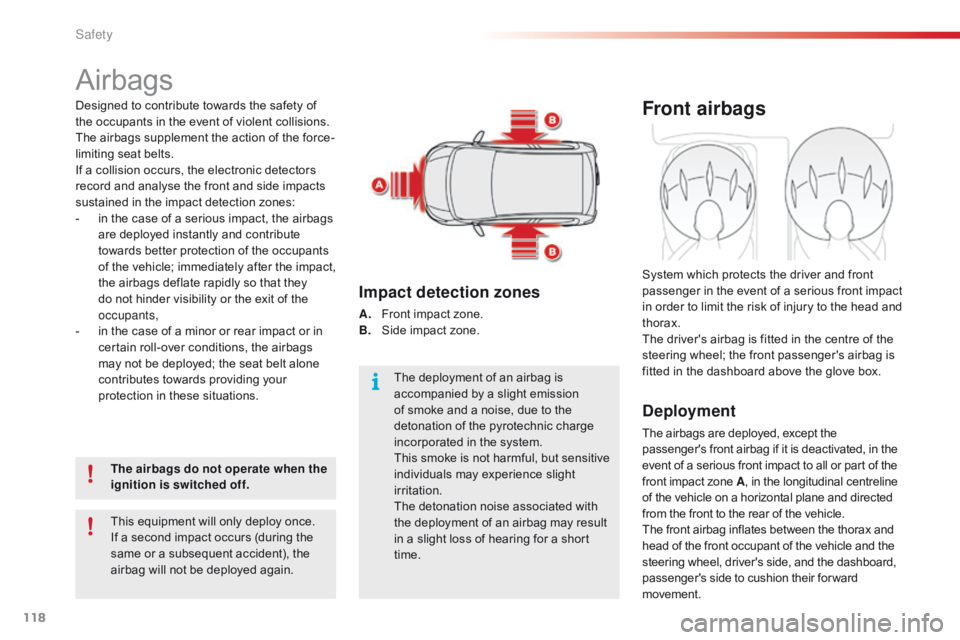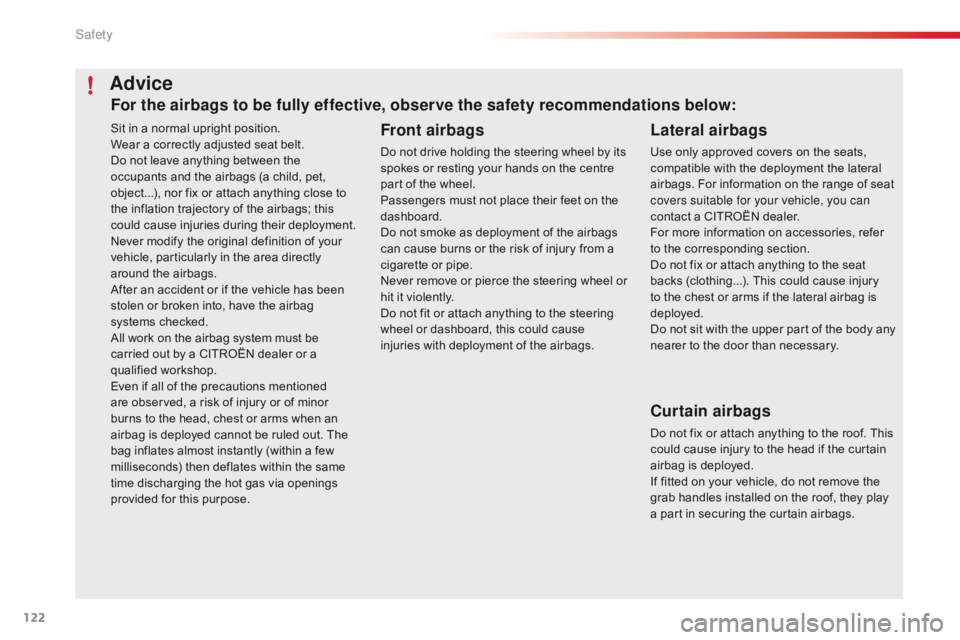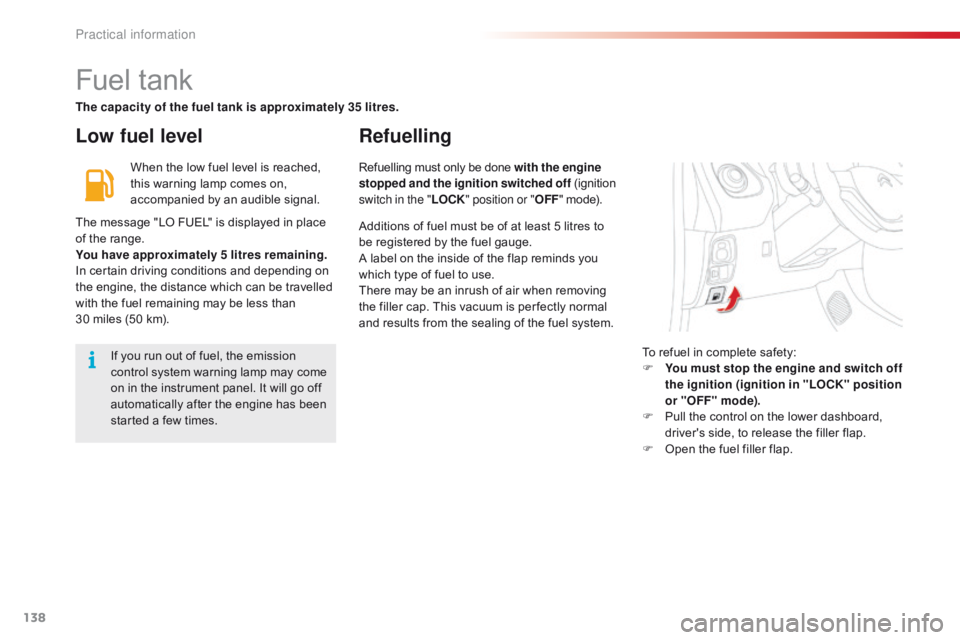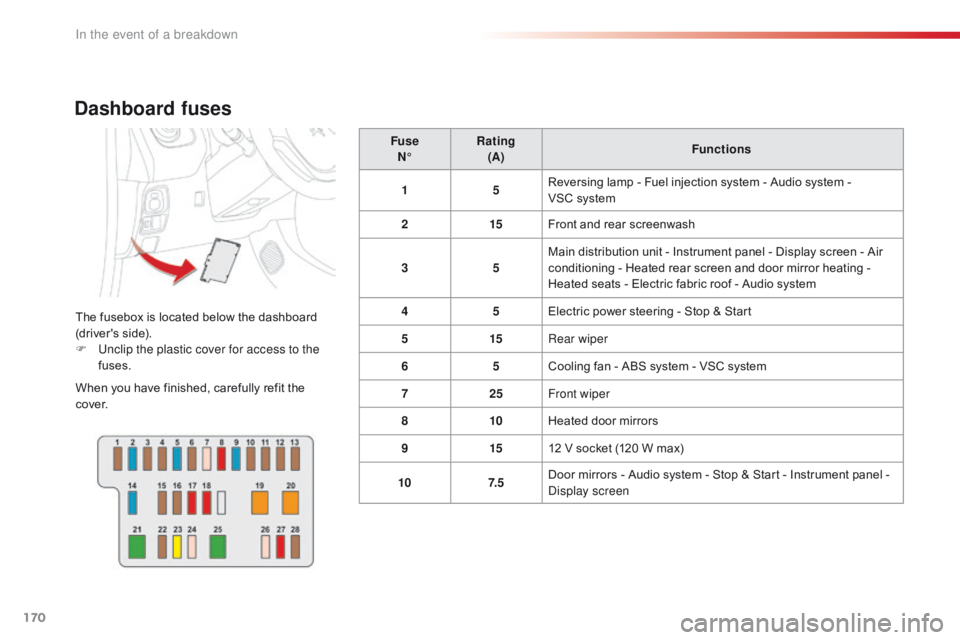dashboard CITROEN C1 2022 Owners Manual
[x] Cancel search | Manufacturer: CITROEN, Model Year: 2022, Model line: C1, Model: CITROEN C1 2022Pages: 269, PDF Size: 7.63 MB
Page 8 of 269

6
C1_en_Chap00b_vue-ensemble_ed01-2016
Dashboard fuses 168 -172
Instruments and controls
Door mirrors 5 0
Electric windows 4 1Courtesy
lamp
6
2
Control for electric fabric roof
4
2
Rear view mirror
5
1
Sun visors
6
4
Manual
par
king
b
rake
7
6Heating,
v
entilation
5
2-54
Manual
a
ir
c
onditioning
5
5-56
Automatic air conditioning
5
7-59
Windscreen demist / defrost
6
0
Rear screen demist / defrost
6
1
7-inch touch screen tablet
1
85 -234
Audio system
2
35 -254
Setting the time
2
9, 30
Manual
g
earbox
7
6
ETG
electronic gearbox
7
7- 80
Gear
shift indicator
8
1
Hill
start assist
8
2
12
V accessory socket
6
4
USB
port
6
5
Jack
auxiliary socket
6
5
Instrument
panel
1
1-12
Rev counter
1
2
Central screen
1
3
Indicator and warning lamps
1
5 -25
Indicators
2
6
Trip computer
2
7-28
Side air vents
5
2
Passenger's front airbag
1
19
Glove box
6
4
Deactivating
t
he
p
assenger's
f
ront
ai
rbag
1
19
Reinitialising t he u nder-inflation d
etection 9 6-97
O
Page 120 of 269

118
C1_en_Chap06_securite_ed01-2016
Airbags
Designed to contribute towards the safety of the occupants in the event of violent collisions.
T
he airbags supplement the action of the force-
limiting
seat belts.
If
a collision occurs, the electronic detectors
r
ecord and analyse the front and side impacts
s
ustained in the impact detection zones:
-
i
n the case of a serious impact, the airbags
a
re deployed instantly and contribute
t
owards better protection of the occupants
o
f the vehicle; immediately after the impact,
t
he airbags deflate rapidly so that they
d
o not hinder visibility or the exit of the
o
ccupants,
-
i
n the case of a minor or rear impact or in
c
ertain roll-over conditions, the airbags
m
ay not be deployed; the seat belt alone
c
ontributes towards providing your
p
rotection in these situations.
The airbags do not operate when the
ignition is switched off. The
deployment of an airbag is
a
ccompanied by a slight emission
o
f smoke and a noise, due to the
d
etonation of the pyrotechnic charge
i
ncorporated in the system.
This
smoke is not harmful, but sensitive
i
ndividuals may experience slight
ir
ritation.
The
detonation noise associated with
t
he deployment of an airbag may result
i
n a slight loss of hearing for a short
t
ime.
This
equipment will only deploy once.
I
f a second impact occurs (during the
s
ame or a subsequent accident), the
a
irbag will not be deployed again.
Impact detection zones
A. Front impact zone.
B. S ide impact zone.
Front airbags
Deployment
The airbags are deployed, except the passenger's front airbag if it is deactivated, in the e
vent of a serious front impact to all or part of the
f
ront impact zone A,
in the longitudinal centreline
o
f the vehicle on a horizontal plane and directed
f
rom the front to the rear of the vehicle.
The
front airbag inflates between the thorax and
h
ead of the front occupant of the vehicle and the
s
teering wheel, driver's side, and the dashboard,
p
assenger's side to cushion their for ward
m
ovement.
System
which protects the driver and front
p
assenger in the event of a serious front impact
i
n order to limit the risk of injury to the head and
t
horax.
The driver's airbag is fitted in the centre of the
s
teering wheel; the front passenger's airbag is
f
itted in the dashboard above the glove box.
Safety
Page 124 of 269

122
C1_en_Chap06_securite_ed01-2016
Sit in a normal upright position.
W ear a correctly adjusted seat belt.
Do
not leave anything between the
o
ccupants and the airbags (a child, pet,
o
bject...), nor fix or attach anything close to
t
he inflation trajectory of the airbags; this
c
ould cause injuries during their deployment.
Never
modify the original definition of your
v
ehicle, particularly in the area directly
a
round the airbags.
After
an accident or if the vehicle has been
s
tolen or broken into, have the airbag
s
ystems checked.
All
work on the airbag system must be
c
arried out by a CITROËN dealer or a
q
ualified
w
orkshop.
Even
if all of the precautions mentioned
a
re observed, a risk of injury or of minor
b
urns to the head, chest or arms when an
a
irbag is deployed cannot be ruled out. The
b
ag inflates almost instantly (within a few
m
illiseconds) then deflates within the same
t
ime discharging the hot gas via openings
p
rovided for this purpose.Front airbags
Do not drive holding the steering wheel by its spokes or resting your hands on the centre
p
art of the wheel.
Passengers
must not place their feet on the
das
hboard.
Do
not smoke as deployment of the airbags
c
an cause burns or the risk of injury from a
c
igarette or pipe.
Never
remove
or
pierce
the
steering
wheel
or
h
it it violently.
Do
not fit or attach anything to the steering
w
heel or dashboard, this could cause
i
njuries with deployment of the airbags.
Advice
Lateral airbags
Use only approved covers on the seats, compatible with the deployment the lateral
a
irbags. For information on the range of seat
c
overs suitable for your vehicle, you can
contact
a CITROËN dealer.
For
more information on accessories, refer
t
o the corresponding section.
Do
not fix or attach anything to the seat
b
acks (clothing...). This could cause injury
t
o the chest or arms if the lateral airbag is
d
eployed.
Do
not sit with the upper part of the body any
n
earer to the door than necessary.
Curtain airbags
Do not fix or attach anything to the roof. This could cause injury to the head if the curtain
a
irbag is deployed.
If
fitted on your vehicle, do not remove the
g
rab handles installed on the roof, they play
a
part in securing the curtain airbags.
For the airbags to be fully effective, observe the safety recommendations below:
Safety
Page 140 of 269

138
C1_en_Chap07_info-pratiques_ed01-2016
Fuel tank
Low fuel levelRefuelling
When the low fuel level is reached, t
his warning lamp comes on,
a
ccompanied by an audible signal.
The
message "LO FUEL" is displayed in place
o
f
the
range.
You have approximately 5 litres remaining.
In
certain
driving conditions and depending on
t
he
engine, the distance which can be travelled
w
ith
the
fuel remaining may be less than
3
0 miles
(50 km). To
refuel in complete safety:
F
Y
ou must stop the engine and switch off
the ignition (ignition in "LOCK" position
or "OFF" mode) .
F
P
ull the control on the lower dashboard,
d
river's side, to release the filler flap.
F
O
pen the fuel filler flap.
If
you run out of fuel, the emission
c
ontrol system warning lamp may come
o
n
in the instrument panel. It will go off
a
utomatically after the engine has been
s
tarted a few times. Refuelling
must only be done with the engine
stopped and the ignition switched off ( ignition s
witch in the "LOCK" position or " OFF"
mode).
The capacity of the fuel tank is approximately 35 litres.
Additions of fuel must be of at least 5 litres to
b
e registered by the fuel gauge.
A
label on the inside of the flap reminds you
w
hich type of fuel to use.
There
may be an inrush of air when removing
t
he filler cap. This vacuum is per fectly normal
a
nd results from the sealing of the fuel system.
Practical information
Page 148 of 269

146
C1_en_Chap07_info-pratiques_ed01-2016
Bonnet
Do not open the bonnet when there is a
very strong wind.
When
the engine is hot, handle the
e
xterior safety catch and the stay with
c
are (risk of burns).
F
P
ush the exterior safety catch to the left
a
nd raise the bonnet.
F
U
nclip the bonnet stay from its housing.
F
F
ix the stay in the notch to hold the bonnet
ope
n.
Opening
F Pull
towards you the interior release lever, l
ocated in the lower dashboard.
The cooling fan may star t after
switching off the engine: take care
with articles and clothing that might
be caught by the fan blades.
Closing
F Take the stay out of the support notch.
F C lip the stay in its housing.
F
L
ower the bonnet and release it near the
e
nd of its travel.
F
P
ull on the bonnet to check that it is fully
l
atched.
Because of the presence of electrical
equipment
under
the
bonnet,
it
is
r
ecommended
that
exposure
to
water
(
rain,
washing,
...)
be
limited.
Practical information
Page 170 of 269

168
C1_en_Chap08_en-cas-pannes_ed01-2016
Changing a fuse
Access to toolsThe fuseboxes are located behind the dashboard in the passenger compartment and
n
ext to the battery under the bonnet.
The
extraction tweezer is fixed at the front of
t
he
u
nderbonnet
f
usebox.
F
U
nclip the plastic cover, located below
t
he windscreen, by pressing on the two
c
atches.F
U
nclip the fusebox cover by pressing on
t
he lug on the right.
F
R
emove the tweezer.
When
unclipping the plastic cover, take
c
are not to remove the seal.
In the event of a breakdown
Page 172 of 269

170
C1_en_Chap08_en-cas-pannes_ed01-2016
Dashboard fuses
The fusebox is located below the dashboard (driver's side).
F
U
nclip the plastic cover for access to the
fuses.
When
you have finished, carefully refit the
c
ove r. Fuse
N° Rating
(A) Functions
1 5Reversing lamp - Fuel injection system - Audio system -
V
SC system
2 15Front and rear screenwash
3 5Main distribution unit - Instrument panel - Display screen - Air
c
onditioning - Heated rear screen and door mirror heating -
H
eated seats - Electric fabric roof - Audio system
4 5Electric power steering - Stop & Start
5 15Rear wiper
6 5Cooling
fan - ABS system - VSC system
7 25Front wiper
8 10Heated
door mirrors
9 1512
V socket (120 W max)
10 7. 5Door
mirrors - Audio system - Stop & Start - Instrument panel -
D
isplay screen
In the event of a breakdown
Page 258 of 269

256
C1_en_Chap11_index-alpha_ed01-2016
Key ............................................................ 31, 71
Key, electronic ................................................. 34
K
eyless Entry and Starting
.......................3
4, 72
Kit,
han
ds-free
......................................2
04, 247
Kit,
temporary puncture repair
................6
9, 153
K
Jack ...............................................................15 8
Jump starting .............................. ..................178
J
Gauge, fuel........................................ 1 3, 26, 138
Gearbox, ETG ............................... ...... 9, 77, 152
Gearbox,
m
anual
.......................... 9
, 76, 83, 151
Gear
efficiency indicator
.................................81
G
ear lever, manual gearbox
...........................76
G
lossary, audio system
................................23
6
Glove
box
..................................................6
3, 64
E
F
G
Eco-driving ............................... ........................ 9
Economy mode ............................... ..............141
Electronic
brake force distribution
(
EBFD)
...............................
.................107,
10
8
Emergency
braking assistance (EBA)
..........10
7
Emergency
w
arning
lam
ps
...........................10
6
Energy
economy mode
.................................1
41
Engine
c
ompartment
.................................... 14
7
Engine
...............................
.....139, 147, 181, 182
Environment
........ 9
, 33, 47, 53, 61, 95, 150, 179
Filling
the fuel tank
................................ 13
8,
13
9
Filter, air
...............
......................................... 151
Filter, oil
......................................................... 1
51
Filter,
p
assenger
c
ompartment
.....................1
51
Fitting
a wheel
...............................
................161
Fittings,
boot
................................................... 68
F
ittings,
in
terior
............................................... 63
F
lashing
in
dicators
................1
03, 164, 166, 167
Foglamp,
r
ear
...............................
.........10 0,
16
6
Folding
the rear seat backrest
........................48
F
olding/unfolding the door mirrors
.................50
F
requency (radio)
..................................1
94, 242
Fuel ..................................................26,
138, 139
Fuel
c
onsumption
........................................ 9
, 28Hazard
w
arning
lam
ps
..................................10
6
Headlamp
adj
ustment
...................................10
3
Headlamps,
automatic illumination
........ 9
9, 101
Headlamps,
dipped beam
.......................9
8, 164
Headlamps,
main beam
..........................9
8, 164
Head
restraints, rear
.......................................49
H
eating
................
............................... 54, 55, 57
Hill start assist
.................................................8
2
Hooks
...............................
...............................69
Horn ............................................................... 10 6
H
Fusebox, dashboard ..................................... 17 0
Fusebox, e ngine c ompartment .....................17
3
Fuses
................
............................................. 168Identification
.................................................. 18 4
Immobiliser,
e
lectronic
....................................75
I
ndicator lamps, operation
..............................21
I
ndicators,
d
irection
......................................10
3
Inflating
tyres
..............................
..............9, 184
Inflating
tyres and accessories
(using
the kit)
..............................
................15 6
Instrument
panel
...............................
........11,
12
I
SOFIX
...............
....................................13 3 -13 5I
Alphabetical index